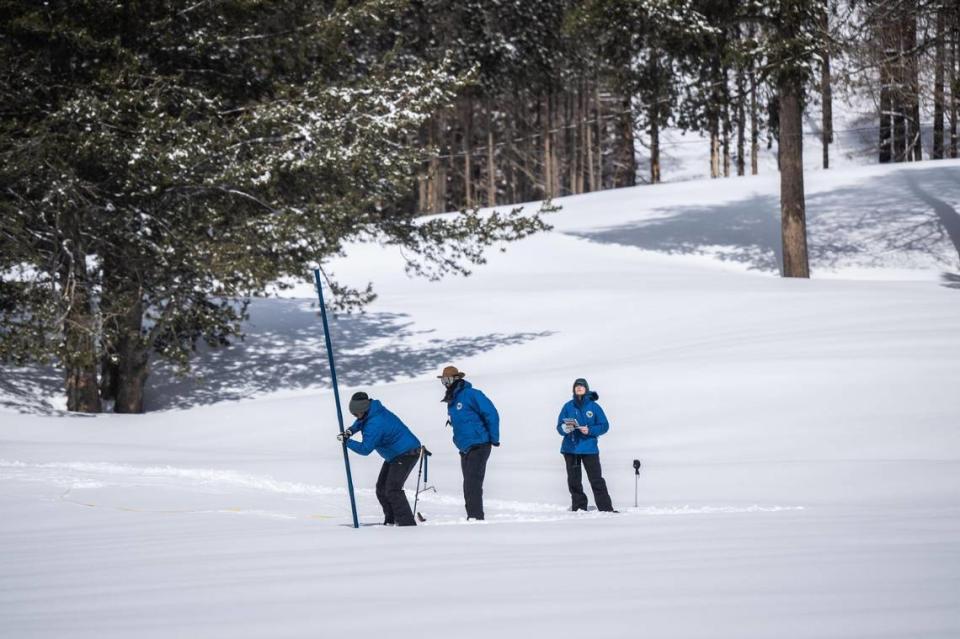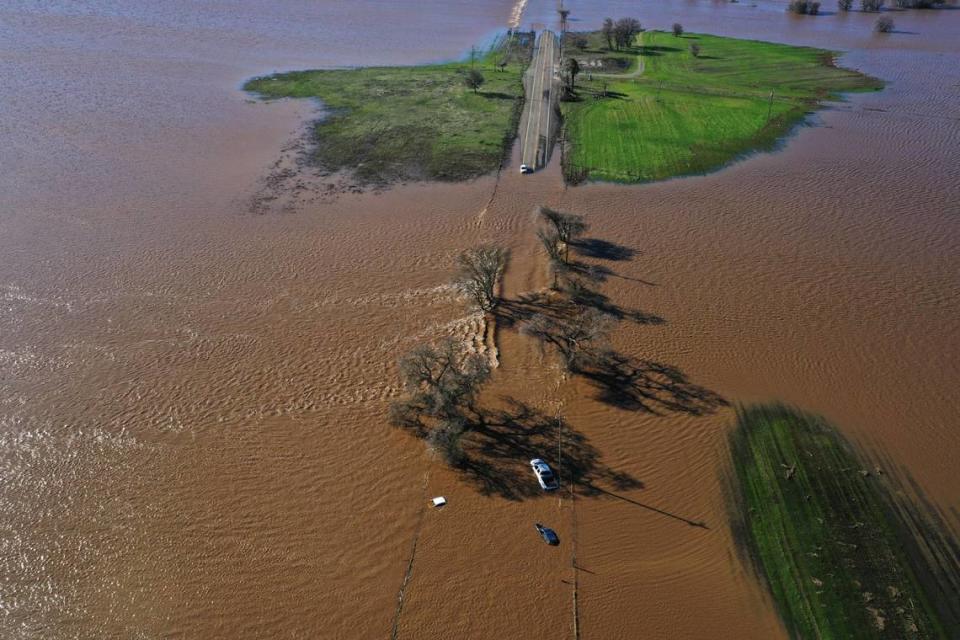Snowiest winter ever? Storms push California to deepest snowpack in at least 40 years
A cavalcade of winter storms have pushed California to an all-time high.
State water officials on Monday announced the deepest snowpack ever recorded across the Sierra Nevada using automated sensors, edging a mark that stood for four decades and tied with a 1952 record that was conducted manually.
Average statewide snow water equivalent was 61.1 inches as of Monday morning, according to automated measurements by the Department of Water Resources. That is 237% of California’s average for the date and 235% of its average for April 1, the state’s typical yearly peak for snowpack.
The latest mark surpasses the winter of 1982-83, when the snow water equivalent reached 227% of the April 1 average.
Sean de Guzman, snow survey manager for the Department of Water Resources, said this past winter’s snowpack is the deepest recorded via snow sensors, which California began using in the early 1980s.
Manual snow surveys in the state date to 1910, de Guzman said, and only three prior years have been recorded at more than double the April 1 snowpack average: 1952, 1969 and 1983.
This year’s snow water equivalent, based on preliminary manual surveys, was 237% of the April 1 average. Additional manual surveys will continue for a few more days, which will allow for more direct comparisons to the 1952 high point, de Guzman said, which was also 237%.
“As of right now, it’s looking like this year’s statewide snowpack will probably, most likely be either the first or second-biggest snowpack on record, dating back to 1950,” de Guzman said as he revealed results Monday at Phillips Station near Echo Summit following the survey.

The southern Sierra tripled the region’s normal snow total, recorded Monday at exactly 300% of the April 1 average. Central Sierra snowpack came in at 237% of normal, and the northern Sierra range at 192%, according to state water data.
“This snowmelt is going to feed those reservoirs throughout the spring and summer, which is a good thing for water supply,” said Karla Nemeth, director of the Department of Water Resources.
“The real challenge as we move into spring and summer, though, is significant flooding, particularly in the Tulare Lake basin.”
Forecasts for spring snowmelt in the Tulare Lake region range from 265% of average to an “absurdly high” 422% of average in some areas, de Guzman said.
Updated statewide runoff forecasts will be available early next week, Nemeth said.
Snow water content measured 54 inches at Phillips Station, or 221% of the April 1 average for that site, de Guzman said during the survey reading, which was live-streamed on social media. It is the site’s fourth-highest total, ranking behind 1952, 1969 and 1983, he said.
Long-range forecasts are not yet clear on whether California is likely to see average, warmer than average or cooler than average temperatures this spring, said Michael Anderson, the state’s climatologist.
“There’s no really clear signal in the climate system right now,” Anderson said in a Zoom news briefing following Monday’s snow survey.
That makes it more difficult to predict just how quickly California’s “monster snowpack” will melt, Anderson said.
The state likely will conduct another snow survey at Phillips Station early next month, Nemeth said, which the Department of Water Resources has not done since 2020.
Light flurries fell on water officials as they collected the results at Echo Summit, with showers lingering from a quick-hitting storm that dropped several inches Sunday in the greater Lake Tahoe area.
The UC Berkeley Central Sierra Snow Lab, located near Donner Pass, said it tallied 7 inches of snow Sunday, pushing the lab’s total for the season to 722 inches — just over double its annual median of 360 inches.
Latest #GOES-West satellite imagery offers a nice view of some clouds over interior #NorCal as well as the snowpack. Mostly dry conditions are forecast for the area with isolated showers up in the northern mountains through this evening. #CAwx
️: https://t.co/sV3bzt2iyE pic.twitter.com/9VzUErGjy5— NWS Sacramento (@NWSSacramento) March 31, 2023
6.7" (17 cm) of #snow over the last day brings our season total to 722" (18.35 m). We now have double our median annual snowfall of 360" (9.15 m)!
Today @CA_DWR will announce the results of the April 1 Snow Survey* and we're expecting well over 200% of normal!#CAwx #CAwater pic.twitter.com/iU6Ch803yE— UC Berkeley Central Sierra Snow Lab (@UCB_CSSL) April 3, 2023
Strong winter storms caused death and destruction
At least 19 atmospheric river storms have struck California since late 2022, according to the Department of Water Resources, with some of the strongest dumping multiple feet of snow per day across parts of the central and southern Sierra Nevada.
The storms also created flashes of rain that created dangerous flooding. Between flooding and heavy snow, authorities tallied more than 20 deaths across California from late December through March, as well as damage and evacuations in the San Joaquin Valley last month, along with a levee failure in Monterey County.

Snow-related deaths extended into the foothills just east of Sacramento. An 80-year-old Foresthill woman died Feb. 28 after her porch collapsed under the weight of snow, Placer County authorities said. Two days later, a 62-year-old El Dorado County man was found dead in the snow near homes in the Camino area, sheriff’s officials said.
“California’s dramatic improvement in water supplies from one year ago has unfortunately led to devastating flood impacts across the state,” de Guzman said following Monday’s snow survey.
“After April 1, we shift our focus away from snowpack building to snowpack melting.”
As warmer rain fell atop fresh snow in mid-March, dozens of roofs collapsed or were damaged in the South Lake Tahoe area, according to Cal Fire. Roofs caved in in other mountains and foothill communities, including the El Dorado County town of Georgetown, fire authorities said.
What about California’s drought?
The parade of winter storms has offered substantial relief to drought conditions across a large majority of the state, which entered this past winter staring at its third consecutive year of drought.
The U.S. Drought Monitor in an update last Thursday showed only 28% of California in “moderate” drought conditions or worse, down from 36% one week earlier. At the end of 2022, 98% of the state was considered to be in at least moderate drought status, according to the federal monitor.
Gov. Gavin Newsom in late March lifted many of the state’s emergency drought measures, including his call for voluntary conservation, in direct response to the winter storms.
Early April snowpack readings are vital for state water officials, who use the figures to forecast expected runoff levels heading into the spring and summer months. That data informs California’s projections for water supply and reservoir levels.
Twelve of California’s 17 major reservoirs were at or above their average levels for this time of year, according to state water data updated Monday, including the two largest, Shasta Lake (106%) and Lake Oroville (116%).
Statewide, reservoir levels stood at 107% of normal, a figure de Guzman said is likely to increase significantly as snow melts this spring and summer.
The Department of Water Resources last month boosted its projection for deliveries by the State Water Project to 75% of requested water, up from 35% announced in February and 5% late last year. The State Water Project supplies water to water agencies that serve 27 million Californians.

